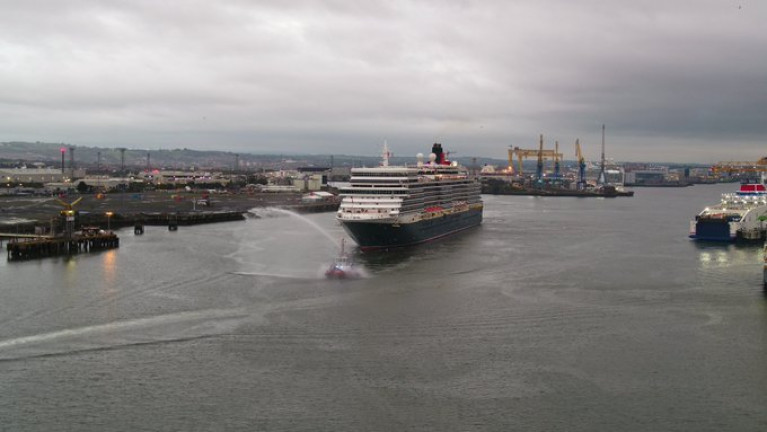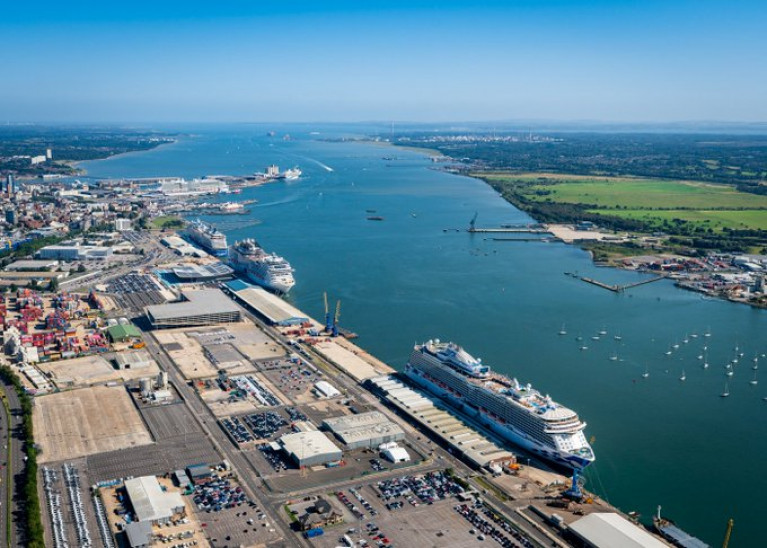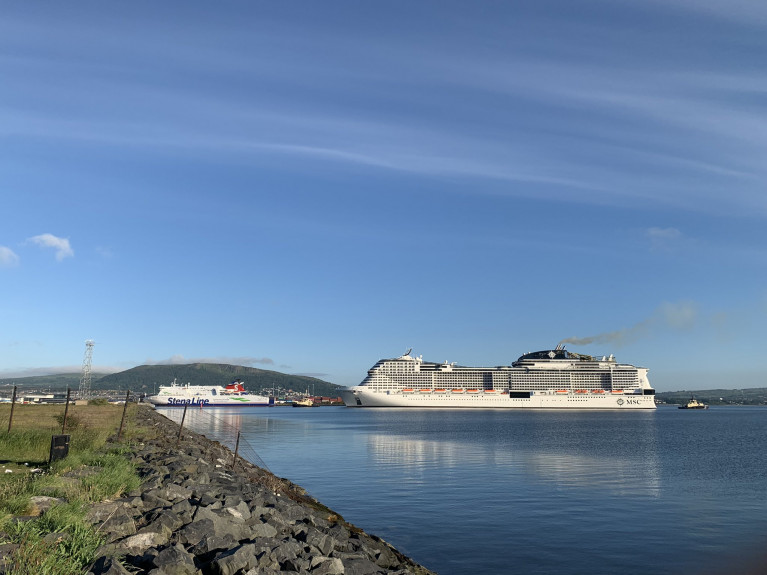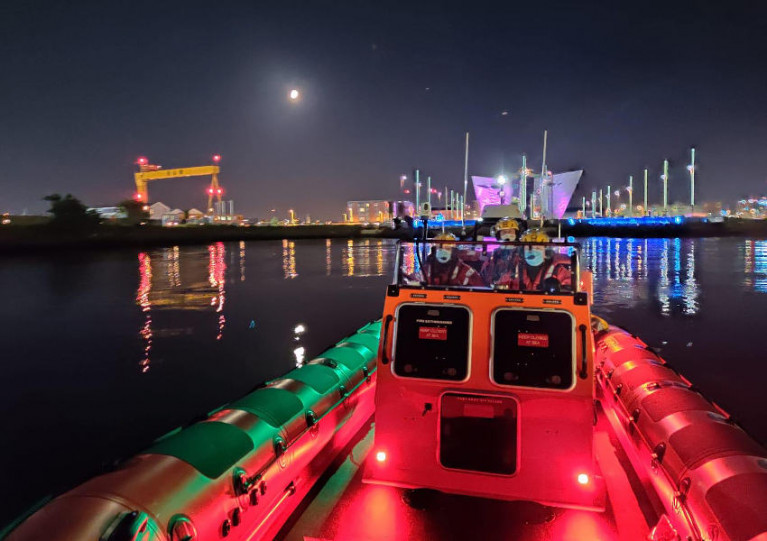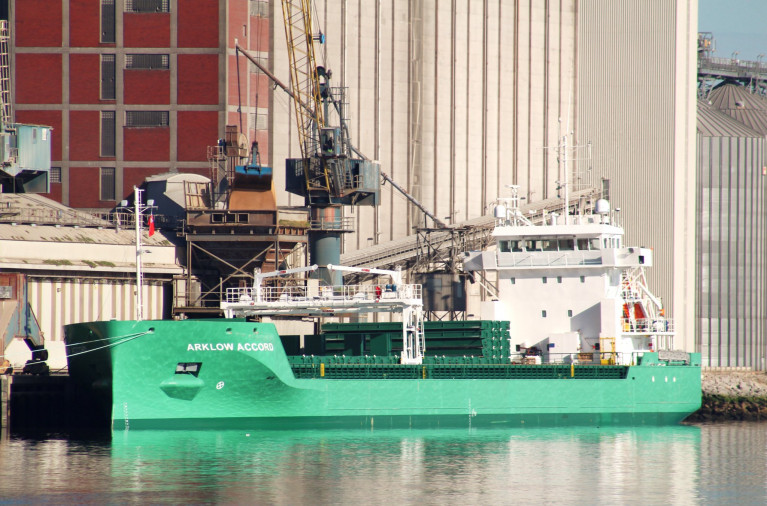Displaying items by tag: Belfast Harbour
Belfast Harbour Invests £1.5m in New Pilot Boat Equipped with Advanced Environmental Features
Belfast Harbour has announced the arrival of its latest pilot boat, the Hibernia, marking a significant investment of £1.5m in its marine fleet. The new vessel will be responsible for ferrying pilots to and from ships at the port, helping them to navigate safely to their designated berths. The pilot boat fleet at Belfast Harbour operates 24 hours a day, 365 days a year, making it essential to minimize downtime.
The Hibernia, constructed by Holyhead Marine Services, boasts a lightweight, resin-infused hull and a fuel-efficient design, with engines that can run on hydrotreated vegetable oil (HVO) to help reduce carbon emissions. It is believed to be the first pilot boat on the island of Ireland equipped with a selective catalytic reduction exhaust system, reducing nitrous oxide emissions.
The new vessel replaces PB4, the oldest pilot boat in Belfast Harbour's fleet, which has been retired after 24 years of service. The name Hibernia has a long history and connection with Belfast Harbour, dating back to 1791 when William Ritchie started shipbuilding in the city, launching the 300-tonne Hibernia a year later.
 Michael Robinson, Port Director and Dr Theresa Donaldson, Chair of Belfast Harbour and godmother of Pilot Boat Hibernia at a traditional naming ceremony
Michael Robinson, Port Director and Dr Theresa Donaldson, Chair of Belfast Harbour and godmother of Pilot Boat Hibernia at a traditional naming ceremony
Dr Theresa Donaldson, Chair of Belfast Harbour, was named as the godmother of the Hibernia during a traditional naming ceremony that sought to bring luck to the vessel and keep the crew safe. Michael Robinson, Port Director at Belfast Harbour, said: "We're committed to becoming a green port, and sustainability is a core element of everything that we do. We were able to incorporate environmental improvements into the design of Hibernia, which will help us on this decarbonisation journey."
Belfast Harbour handles over 23.9 million tonnes of trade each year, making the pilot boat fleet a mission-critical service for the port. The new addition to the fleet will undoubtedly boost its resilience and enhance the port's capacity to serve its customers safely and efficiently.
New Manager Appointed at Stena Line Operations in Belfast Harbour
Darren Byers has been appointed Port Manager at Stena Line based in Belfast Harbour.
With over 20 years’ experience within Maritime operations, Darren joins the ferry and port operator from the Royal National Lifeboat Institution (RNLI) where he was Area Life Saving Manager covering Ireland and the Isle of Man. This year is notably significant, as the RNLI is to celebrate its 200th birthday on 4th March.
An experienced operations manager, Darren, from Bangor Co. Down, will manage the safe, efficient and effective operations in the Belfast terminals and support the success of Stena Line in Belfast Harbour.
He will support Duty Managers and lead the teams in the day-to-day functions at the Port.
The ferry operator has three routes serving Belfast Harbour, connecting Cairnryan, Scotland and Birkenhead (Liverpool) in addition the freight-only service to Heysham also in England.
New Native Oyster Nursery in Belfast Harbour Shows Promising Results
A shellfish nursery recently installed in Belfast Harbour in an effort to revive the Northern Ireland capital’s native oysters is already showing promising results.
Last month, hundreds of oysters were lowered into the water at City Quays for the project, a joint initiative of Belfast Harbour and Ulster Wildlife following similar successful schemes in Bangor and Glenarm, as the News Letter reports.
Simon Gibson, of Belfast Harbour said the new nursery — which returns native oysters to the area after a century’s absense — “is the first in Northern Ireland in a commercial shipping channel”.
With the proper care, these oysters will grow together to form a reef — which is already in the early stages, as Ulster Wildlife’s Dr David Smyth told RTÉ News.
“Imagine 100,000 of these all stuck together; this is what we are after. From them, millions of larvae will settle around the shore and on the seabed,” he said.
The reef will also provide a habitat for a variety of other marine species, making a positive impact on marine biodiversity in the area.
The oysters will also contribute to improved water quality in the port, due to their unique ability to reduce water pollution and improve water clarity.
According to Ulster Wildlife, one native oyster can filter up to 200 litres of water per day, which is the equivalent of a bathtub.
RTÉ News has more on the story HERE.
Manxman, the new 24,161 gross tonnage flagship ferry which was built in an Asian shipyard for the Isle of Man Steam Company, has said that they "won't rush" to have things ready.
The first passenger sailing on the Douglas-Heysham route reports ManxRadio is now 'weeks rather than months' away from entering service according to the Steam Packet Company's managing director.
Brian Thomson says the company "won't rush things to have Manxman in service before it is ready".
In a general update released yesterday on the 950 passenger/crew flagship's progress, the Steam Packet had confirmed that the ferry has been issued with a seaworthiness certificate.
In addition the company said that the vehicle decks received an "improved coating" that was applied to both car decks and that crew training has been taking place.
Manxman has completed berthing trials in Douglas and Heysham and made an initial visit to Belfast which Afloat adds took place on Wednesday, exactly a month after making its maiden arrival to the Isle of Man.
The berthing trials at Albert Quay took about an hour to complete and as can be seen in the photo above is the stern berthed next to the linkspan.
Afloat adds that the statement issued by the Steam Packet said the crew of Manxman and shoreside staff have been working tirelessly to develop and implement operating procedures as real-life knowledge of the vessel grows.
In terms of technology, Manxman is a huge step forward from both the ropax Ben-my-Chree and fast-ferry Manannan, as such the crew requires entirely new ways of working.
When Manxman is introduced, for approximately the first four weeks the flagship will only carry out daytime sailings while Ben-my-Chree will run the overnight sailings.
When this period is over, Manxman will undertake the previously announced cruise, before commencing four weeks of night time sailings, with Ben-my-Chree switching to the daytime schedule.
At the conclusion of the working up period, Manxman will take over fully on the Douglas-Heysham route, replacing the 12,747 gross tonnage Ben-my-Chree which has been in service for 25 years.
The 600 passenger custom-built 'Ben' dating from 1998 will then enter fleet reserve status.
New Lifeboat for Lagan Search and Rescue at Belfast Harbour
Lagan Search and Rescue has a new Class 2 Lifeboat on station.
The independent charity is run by volunteers and based at Belfast Harbour Marina on the River Lagan in the City. It covers all types of search and rescue operations 24/7, including quayside response, swift water and flood rescue, medical response and rescue swimming. A Kayak Rescue Corps is being developed.
The lifeboat was built by Ribcraft and is more suited for the more challenging areas of water in and around rural communities than the larger Atlantic 21 Lifeboat. Capable of 32 knots and equipped with the latest in Search and Rescue technology, the new craft will be a valuable asset and will no doubt save many lives in the years ahead.
The Department of Agriculture, Environment and Rural Affairs (DAERA) released the funding which made the purchase possible early this year
And when a volunteer was refuelling the boat recently at the petrol station, a very generous gentleman kindly paid for the fuel. The gesture was much appreciated.
The 1,000th cruise ship call to Belfast Harbour took place yesterday according to Cruise Belfast, which works in partnership between the port and Visit Belfast.
Cunard Line's MS Queen Elizabeth arrived in Belfast marking a significant milestone for tourism in Northern Ireland, as well as the region’s gradual economic recovery from the pandemic.
Cruise tourism to the city restarted in June this year, with domestic, UK-only cruise itineraries and, to date, the arrival of MS Queen Elizabeth is the 66th cruise call to Belfast this year. The 'Vista' class ship is Cunard's newest luxury ocean liner, which first visited Belfast in 2016 and this will be on a sixth call to Belfast Harbour.
The celebrated arrival of the ‘Berlin’, the first cruise ship to arrive into Belfast in 1996, marked the start of what has been a huge success story for tourism in Northern Ireland, with cruise calls growing year on year, welcoming an incredible 1.7m visitors in the 25 year period.
2019 was a record year for cruise calls, with 146 vessels bringing 285,000 visitors to Northern Ireland, before cruise operations temporarily ceased due to the coronavirus pandemic.
Belfast was named by Cruise Critic as the ‘Best Port of Call’ in the UK and Ireland in 2019 for cruise ships following an investment by the Port to create new quayside facilities and funding from Tourism Northern Ireland for a dedicated cruise Visitor Information Point.
Managed and staffed by Visit Belfast, the terminal uses the latest digital and audio-visual technology to help travel advisors showcase the range of visitor attractions on offer across Belfast and Northern Ireland.
Full Cruise Operations Return at Port of Southampton Sees Consecutive Five-Ship Weekends
Following an easing back to full cruise operations at the UK's main cruise port of Southampton which had its busiest month of the year to date with two consecutive five-cruise ship weekends during August.
On Saturday 7 August and Saturday 14 August, each one of the port’s world-class cruise terminals was occupied as the cruise industry makes its phased return. This is welcome news for holidaymakers as well as for the thousands of local residents who rely on the cruise industry for their livelihood.
During the first five ships day, Ocean Cruise Terminal hosted P&O Cruises’ Iona. The new cruiseship later departed the ship's home port (see May's naming ceremony) for a maiden passenger cruise.
Marella Explorer departed from Queen Elizabeth II Terminal in the Eastern Docks, MSC Cruises’ MSC Virtuosa (Belfast's first bigship caller), fitted with Shore Power connectivity, was at the port’s newest terminal, Horizon Cruise Terminal.
Anthem of the Seas, Royal Caribbean’s second largest ship in its Quantum-class, was at City Cruise Terminal, and Regasothl Princess, Princess Cruises’ Royal-class ship, departed from the Western Docks Mayflower Terminal (adjacent to the Southampton International Boat Show, see story).
On the second weekend, Royal Caribbean’s Celebrity Silhouette was at City Cruise Terminal in place of Anthem of the Seas, with all other ships above returning to their respective terminals for further passenger operations. (These ships Afloat adds also visited Belfast Harbour this season).
Rebekah Keeler, Head of Cruise at ABP, said: “We’re excited to be getting closer to seeing what a ‘normal’ cruise weekend for the port in peak season would be. It’s taken a huge collaborative effort by the industry to bring cruise back safely and it fills us all with pride to see passengers once again beginning their holidays here at the Port of Southampton.”
Before the industry pause, the Port of Southampton would typically welcome two million passengers every year, with each cruise call bringing in over £2.7million into the local economy. The coming months are expected to be busy, with all terminals occupied at weekends and lots of activity on weekdays too.
With the new next-generation-ready Horizon Cruise Terminal now welcoming passengers, and its shore power due for commissioning this year, the strengthening of cruise infrastructure places the Port of Southampton firmly at the forefront of the future of cruise.
Major cruises from British ports will resume this week with a maiden voyage of a vessel around the coast of the UK.
MSC Cruises second ship of the Meraviglia-Plus class, Afloat adds is MSC Virtuosa, which according to the Belfast Telegraph, will leave Southampton (see ship's earlier entry cruise) on Thursday for a four-night cruise. This is to be followed by three and four-night mini-cruises.
From June 12, the 19-deck ship will start to operate longer seven-night sailings through to mid-September. This will offer guests additional embarkation ports in Liverpool and Greenock as well as calls at Portland in Dorset and Belfast (from where Afloat adds arrived this morning from Liverpool).
For comments on the visit by MSC Cruises UK & Ireland's managing director, click the newspaper's link here.
Today's call of the MSC Virtuosa to Belfast Harbour, Afloat adds, follows the first and only cruisecaller last year to Northern Ireland before Covid-19 struck.
On that occasion, Hurtigruten's newbuild hybrid-powered expedition cruiseship MS Fridtjof Nansen made a maiden debut to the city.
Belfast Harbour Extends its Support for Lagan Search & Rescue
Belfast Harbour has pledged support to Lagan Search & Rescue to the tune of £100,000 (€110,000) over the next five years, as the News Letter reports.
The arrangement includes continued provision of an operations base and lifeboat berths for the agency’s search and rescue services to the River Lagan and Belfast Lough.
A recent boost to the volunteer-run service was the addition of a new eight-metre lifeboat, funded in part by Belfast Harbour and the Northern Ireland Department for Transport’s Inshore/Inland Rescue Boat Grant Fund.
The News Letter has more on the story HERE.
Belfast Harbour Reports of Solid Annual Results for 2019
A sound financial performance is how Belfast Harbour has reported figures for 2019 and this in line with expectations of providing a strong platform from which to respond to challenges posed by the impact of Covid-19 on the local and global economy.
Releasing its annual results last month, Belfast Harbour reported turnover of £65.9m in the year to the end of 2019 (down 4%) and generated operating profits of £30.6m (down 15% from the record results of 2018). The decline in earnings largely reflected the completion of a major offshore windfarm contract mid-2018 and the ongoing decline in power station coal throughput.
Trade remained strong during the year, with more than 24 million tonnes of cargo passing through the port. Ferry passenger numbers exceeded 1.5m for the third year in a row, there were a record number of freight vehicles - up 4% to 542,000 – and cruise ship activity also continued to grow, with 280,000 cruise visitors during the year.
During 2019, £44m was invested in a range of port and estate projects, with £40m invested to automate container handling and upgrade the Belfast -Liverpool ferry terminal, in readiness for the introduction of larger new Stena Line vessels. Construction also commenced on City Quays 3, which will be Northern Ireland’s largest ever Grade ‘A’ office building. The last remaining office space in the City Quays 2 building was occupied during the year.
In 2019 Belfast Harbour committed £115.7m in further investment in strategically significant projects to help deliver its vision of becoming the best regional port and an iconic waterfront for Belfast. These investments will be a critical enabler of NI’s Covid-19 recovery, given the Port’s recognised role as a key driver of the regional economy.
In the past 10 years Belfast Harbour has invested over £290m in port infrastructure and estate regeneration, which as a Trust Port it entirely self-funded - with all profits reinvested back into developing the Port for the benefit of customers and the wider economy.


























